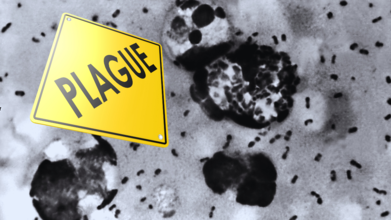- Health Conditions A-Z
- Health & Wellness
- Nutrition
- Fitness
- Health News
- Ayurveda
- Videos
- Medicine A-Z
- Parenting
1,500-Yr-Old Mystery Unearthed: DNA Study Reveals Cause of the Justinian Plague, World’s First Pandemic

Credits: Canva
For centuries, historians and scientists have debated what exactly triggered the Justinian Plague, a catastrophic pandemic that began in 541 AD and ravaged the Byzantine Empire for over two centuries. There were so many theories and guesses but hard biological proof was always missing. Now, the researchers dug into a mass grave in Jerash, an ancient Roman city in present-day Jordan, and uncovered the genetic pathogen: Yersinia pestis, the bacterium infamous for causing plague.
The discovery, published in the journal Genes, finally ties the Justinian Plague to the same microbe that would later fuel the Black Death in mediaeval Europe.
As Dr Rays HY Jiang from the University of South Florida summed up, "This discovery provides the long-sought definitive proof of Y pestis at the epicentre of the Plague of Justinian."
What Was the Justinian Plague?
If you think Covid-19 was disruptive, imagine a pandemic that stretched across centuries. Between 541 and 750 AD, the Justinian Plague killed tens of millions, weakened armies, wrecked economies, and reshaped the Byzantine Empire.
It first appeared in Pelusium, an Egyptian port city, before sweeping through the Eastern Roman Empire like wildfire. The sheer scale of death was so staggering that some historians argue it permanently altered the course of European history. And yet, until recently, no one could prove with certainty what caused it.
“For centuries, we have relied on written accounts describing a devastating disease but lacked any hard biological evidence of the plague's presence. Our findings provide the missing piece of that puzzle,” Dr Jiang explained.
Digging Up the Past, Tooth by Tooth
Archaeologists excavated burial chambers beneath Jerash’s former Roman hippodrome—a structure once used for chariot races and grand public spectacles. There, they discovered human remains from victims of the plague.
"Using targeted ancient DNA techniques, we successfully recovered and sequenced genetic material from eight human teeth excavated from burial chambers beneath the former Roman hippodrome in Jerash, a city just 200 miles from ancient Pelusium,” said Greg O'Corry-Crowe, another author of the study.
The analysis revealed nearly identical strains of Yersinia pestis, meaning the outbreak spread quickly and with devastating impact, just as historical texts described.
From Entertainment Hub to Emergency Cemetery
What makes Jerash especially symbolic is its transformation during the crisis. Once a buzzing trade hub with impressive Roman structures, it suddenly became a burial site.
"Jerash was one of the key cities of the Eastern Roman Empire, a documented trade hub with magnificent structures,” Dr Jiang said.
“That a venue once built for entertainment and civic pride became a mass cemetery in a time of emergency shows how urban centres were very likely overwhelmed.”
It is a sobering reminder of how pandemics can flip the world upside down, turning arenas of joy into sites of despair.
Lessons That Still Matter Today
The Justinian Plague may feel like ancient history, but its echoes reach into our present. Plague has not disappeared; it lingers quietly in the background, occasionally resurfacing.
"We have been wrestling with plague for a few thousand years, and people still die from it today," said Dr Jiang. "Like Covid, it continues to evolve, and containment measures evidently cannot get rid of it. We have to be careful, but the threat will never go away.”
That statement might sound chilling, but it is also a reminder: disease, no matter how old, never truly leaves us. The more we learn from ancient outbreaks, the better prepared we are to face future ones.
What Now?
By decoding the genome of Yersinia pestis from the Justinian era, scientists can better understand how the bacterium has evolved and survived across millennia. It also points out how pandemics have always shaped societies—toppling empires, shifting populations, and altering human history.
Cancer Cells Cheat Drugs, Pretends To Be Dead, To Avoid Treatment: Study

Credits: Canva
The World Health Organization (WHO) notes that in 2022, there were nearly 20 million new cancer case in the world. These have included lung, breast, and colorectal cancers. This has led to death of 9.7 million in the year. This means about 1 in 5 people could develop cancer in their lifestyle, and the number is rising significantly by 2050.
While there are new studies, targeted cell therapies that are now opening more doors to cancer treatments, a new study by the University of California, San Diego, could be worrisome. This new study found that some cancer cells turn on their "cell death" mode during drug therapy. So, what happens is that the drug, instead of killing them, persist and regrow in some of the case. This is how drug resistance in cancer cells functions, and by targeting this cell-death programme in cancer cells, scientists could potentially stop the growth of cancer after therapy.
The findings have been found in a peer-reviewed journal Nature Cell Biology.
Why cancer often comes back
Cancer remains one of the biggest global health threats, causing nearly 10 million deaths every year. One of the hardest parts of treating cancer is that it can return, even after treatment seems successful. Doctors call this cancer relapse or recurrence. It happens when some cancer cells survive the first round of treatment and begin growing again after a period of dormancy.
Relapse rates vary by cancer type. Lung cancer, for instance, has a higher chance of returning, while breast cancer generally has lower relapse rates. Still, one problem cuts across many cancers: drug resistance. Over time, cancer cells can learn how to survive medicines designed to kill them.
A surprising discovery during treatment
In this study, researchers set out to look for early signs of drug resistance in cancer cells. They expected to find genetic changes or mutations. Instead, they found something unexpected. Some cancer cells respond to treatment by turning into what scientists call “persister cells.”
These persister cells stop growing during therapy and enter a dormant state. At first glance, this looks like success. But what happens next is more troubling. These cells activate a built-in cell death program, the same process the body uses to break down dying cells. However, the program does not finish the job.
How cancer cells escape death
Rather than dying, these persister cells release enzymes that help them restart growth. One key enzyme involved is DNA Fragmentation Factor B, or DFFB. Normally, DFFB helps fragment DNA in cells that are meant to die. In these cancer cells, it is activated at low levels. That is not enough to kill the cell, but enough to help it escape dormancy and start growing again.
“This flips our understanding of cancer cell death on its head,” said senior author Matthew J. Hangauer. He explained that signals meant to kill cancer cells can sometimes help them survive and regrow instead.
What this means for cancer treatment
The findings offer a new way to think about drug resistance. Instead of relying on genetic mutations, cancer cells may use internal survival mechanisms to outlast treatment. This insight opens the door to new treatment strategies.
The researchers tested this idea by disabling DFFB in melanoma, lung cancer, and breast cancer models. Without the enzyme, the cancer cells stayed dormant and could not restart growth. Importantly, DFFB does not appear to be essential in normal cells, suggesting that targeting it may not cause major side effects.
As first author August F. Williams noted, focusing on these early, non-genetic survival pathways could help patients stay in remission longer and lower the risk of cancer returning.
Highly Contagious And Hard To Kill Winter Vomiting Disease Is Spreading In The US, Here's How To Avoid It

Credits: Canva
Winter vomiting disease cases are rising. This is highly contagious and is spreading rapidly across the United States. We are talking about norovirus. This contagious stomach flu has led to health officials raising warning for people to take extra precautions. In fact, experts say that the number of people affected could be higher, all thanks to holiday gathering season.
What makes Norovirus unique is that this virus is particularly hard to kill and many do not even realize that they are spreading it, unless it is too late.
The Centers for Disease Control and Prevention (CDC) has noted that the cases of norovirus has spiked ever since the Thanksgiving holiday. they have also noted that this particularly hard to kill virus is also known as the "winter vomiting disease".
For now cases of this winter vomiting disease have been reported from Illinois, the Midwest, and Southern California. The California Department of Public Health has also noted a rise in cases in Los Angeles and San Francisco Bay areas.
The contagious virus affects the gastrointestinal system, causes vomiting, stomach pain, and diarrhea that could last several days. The symptoms usually take 12 to 48 hours to appear after the exposure.
New Strain Of The Unique Norovirus In 2025
There has been an emergence of a new strain GII.17. This could lead to an increase of 50% more infections than this year, said the CDC. Medical experts have urged the public to stay alert and practice goof hygiene.
As per the DuPage Country Health Department's social medica awareness post, "cases of norovirus are continuing to increase". "Norovirus is very contagious, and anyone can get infected and sick," the health department wrote on Facebook.
How To Avoid Getting Sick From Winter Vomiting Disease?
Dr Suman Radhakrishna, Director of Infectious Disease at Dignity Health Medical Center, tells KTLA, "It [the virus] can stay on doorknobs and food and it’s pretty hearty. When someone ingests it or touches it and then places their hand on their mouth, they can get the virus. You don’t need a lot of the virus to get infected.”
“Whether you have the virus or not, sing the Happy Birthday [song] twice when you’re washing with soap and water, especially before you eat,” Radhakrishna advised. “Other times, the hand sanitizer works, but it doesn’t work very well for norovirus, unfortunately.”
Other practices to follow is to avoid touching your face with dirty hands, or avoid touching food or items that could have been handled or touched by other people. Disinfect any surface, which could have been contaminated.
If you already have it, the doctor suggests to seek care in the emergency room and keep drinking enough fluids. "Or let’s say, if you were lying down and when you try to sit up, you feel dizzy because you are so dehydrated, these are times when you should call your doctor, go to the emergency room or go to urgent care,” said Dr Radhakrishna.
Symptoms Of Norovirus
- Diarrhea
- Vomiting
- Nausea
- Stomach pain
- Fever
- Headache
- Body aches
Melanie Sykes Reveals She’s Living With ‘Post-Traumatic Growth’; Here’s How It Differs From PTSD

Credits: Canva/Melanie Sykes Instagram
Melanie Sykes has shared an encouraging health update, revealing that she is experiencing what she describes as “Post-Traumatic Growth.” On Friday, the former television presenter, 55, spoke openly on Instagram about feeling “vibrating high” after what she called moving through deep trauma. Her comments come amid an ongoing struggle with an autoimmune condition that has caused widespread inflammation and left her almost two-thirds bald.
Melanie Sykes Reveals She’s Living With ‘Post-Traumatic Growth’
In her message, Sykes reflected on how difficult periods do not last forever and introduced the idea of post-traumatic growth to her followers. She explained that it is possible to live with PTSD while also experiencing growth at the same time. “I’m in both camps,” she said, adding that people can hold pain and progress together, as long as they take care of themselves, allow space for grief, process what has happened, and then move forward in ways that bring happiness and meaning.
What Is ‘Post-Traumatic Growth’
Post-Traumatic Growth, often referred to as PTG, describes the positive psychological change that can emerge after someone has faced severe stress or trauma. Rather than simply managing or surviving the experience, people may find new depth in how they see life, feel stronger connections with others, discover fresh possibilities, or undergo spiritual or existential shifts. According to the National Institute of Health, PTG is not about bouncing back to how life was before. Instead, it reflects a deeper transformation that can take a person beyond their pre-trauma sense of self.
How Is Post Traumatic Growth Different From PTSD?
Post-Traumatic Stress Disorder, or PTSD, is marked by ongoing distress following trauma, including intrusive thoughts, avoidance, heightened alertness, and emotional suffering. PTG, on the other hand, refers to the positive psychological changes that can arise after working through trauma, such as greater appreciation for life, stronger relationships, personal strength, and shifts in belief or purpose. As noted by the National Institute of Health, the key difference lies in the outcome. PTSD is considered a mental health disorder, while PTG is a process of meaning-making and growth. Importantly, the two can exist together, with some individuals experiencing distress and growth at the same time.
At its core, PTSD reflects the painful impact of trauma, while post-traumatic growth represents the possibility of positive change that can develop through the long and often difficult path of healing, sometimes alongside or after living with PTSD.
What Condition Is Melanie Sykes Going Through?
Melanie lives with an autoimmune condition, a disorder in which the body’s immune system, meant to protect against infections, wrongly targets its own healthy cells, tissues, and organs. This immune response leads to inflammation and ongoing damage. Common autoimmune diseases include lupus, rheumatoid arthritis, and type 1 diabetes. Although there is no cure, treatment usually focuses on controlling symptoms such as fatigue, pain, and swelling and helping people manage the condition in daily life.
© 2024 Bennett, Coleman & Company Limited

